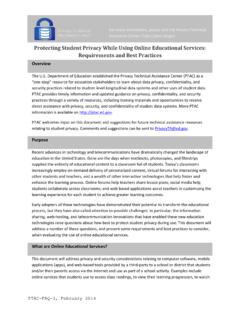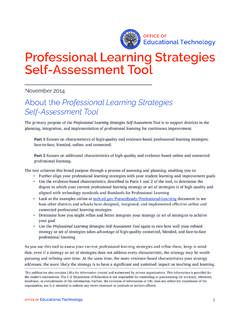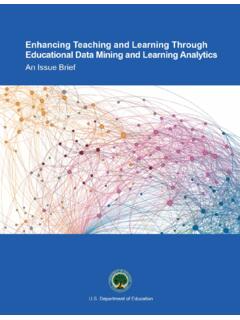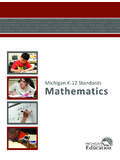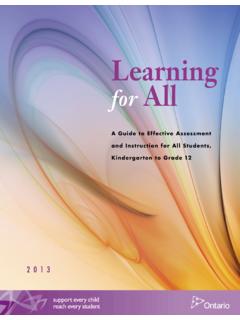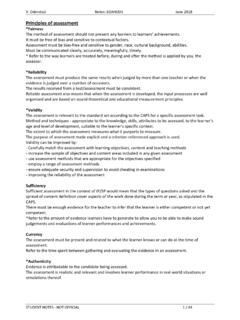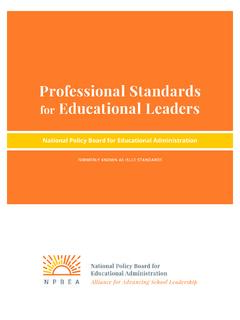Transcription of MATRIX 1: Digital Learning Resources
1 22 MATRIX 1: Digital Learning Resources The term Digital Learning Resources (DLRs) refers to Digital Resources such as applications (apps), software, programs, or websites that engage students in Learning activities and support students Learning goals. There are three categories of DLRs: Digital academic content tools, Digital productivity tools, and Digital communication tools. DLRs as defined here do not include the hardware or infrastructure needed to use the Digital Resources . DLR Category Definition Category Types and Examples Digital Academic Content Tools Software, applications (apps), programs, or websites that offer academic content Resources and/or engage students in activities to learn academic content or skills, including, but not limited to, language and literacy content or skills. Designed Learning activities Interactive tutorials or lessons (adaptive and other) that guide students in Learning and demonstrating new content or skills, such as an interactive lesson on the life cycle of a butterfly or a math tutorial on fractions.
2 Practice and assessment tools that provide activities to review concepts and skills, such as a math app that provides multiple opportunities to practice addition skills. Dynamic modeling or simulation tools, such as a physics simulation that lets students manipulate virtual equipment, change parameters, and see the results. Virtual worlds that immerse a student in a fully interactive environment, such as one that allows a student to roam in a period of past history or explore a desert environment. References/ Resources Dictionaries, encyclopedias, e-books, topic blogs, and/or topic-focused websites that serve as information Resources , such as an online encyclopedia that offers students pictures, facts, and videos about mammals or a Digital dictionary. Visual and auditory topic-related Resources such as a YouTube video on earthquakes and plate tectonics.
3 Language resource tools Translation tools that assist students by providing a translation to another language. Articulation tools that assist a student to accurate production of a language, such as by showing images of how a sound should be produced and/or by letting a student record and listen to his/her own voice to compare with the model. Digital Productivity Tools Software, applications (apps), programs, or websites that students use to plan, document, organize, and analyze content. They do not contain academic content. Presentation tools Presentation and publication tools that allow students to demonstrate what they have learned about a topic or to publish a Digital story about a memorable day. These may include music, images, and/or video. Word processing tools Word or text processing tools that enable students to create, edit, and print documents such as in creating a newspaper based on topics from history class or reporting on a field trip.
4 Information analysis tools Spreadsheet and data analysis tools that allow students to organize and analyze information, such as tracking local rainfall over time or analyzing and summarizing factors that led to the migration from the American Dust Bowl to the West in the 1930s. Information organization tools Concept-mapping tools that let students visually represent relationships among sets of information, such as creating a mindmap of the American Revolution or a concept map for the causes of the Civil War. Story templates that assist students to communicate a narrative using text and/or images, as in retelling a story they have heard. Digital Communication Tools Software, applications (apps), programs, or websites that students use to communicate, collaborate, network, or present information. They do not contain academic content.
5 Asynchronous/ synchronous text communications Discussion boards or forums that provide platforms for students to post reactions and/or comments and share perspectives, such as in providing analyses of a novel they have read and sharing feedback on their peers analyses. Emails, text messaging, chats, for example, using a chat function to share peer feedback on a report. Reflection tools Blogs or student journals that allow students opportunities to share and/or reflect on their Learning experiences, such as a student who uses a journal entry to reflect on her understanding of particular math concepts. Videoconferencing/ meeting tools Videoconferencing or meeting tools that provide a remote means of seeing and speaking with others in real time, such as in enabling a science class to see and talk with NASA experts, or allowing students in a Spanish dual-language class to see and share a geography game with Spanish-speaking peers in Mexico.
6 Project collaboration tools Document or project-sharing tools that provide an online platform where students can work on products together, as in jointly editing a shared book report. Multiple individual DLRs can be combined in an Integrated DLR Set Integrated DLR Sets A structured combination of individual DLRs to provide a complete core or supplemental curriculum. Often, DLR sets are licensed as a package by a school district. Core Curriculum Integrated DLR Set For example, a math program for grades 6 8 that combines visual lessons with embedded assessments, productivity tools, and flexible class management tools into one package. Supplemental Integrated DLR Set For example, a math intervention for at-risk students in grades 6 12 that provides tutorials, practice activities, and progress monitoring tools to inform instruction.
7 Note: This summary MATRIX was adapted from Zehler, Annette M., Yilmazel-Sahin, Yesim, Massoud, Lindsey, Moore, Sarah C., Yin, Chengbin, and Kramer, Kat. (2012, April). Technology-based Resources in instruction of English learner students. Poster presentation at the Annual Meeting of the American Educational Research Association, Vancouver, British Columbia. Source: Department of Education, Office of Planning, Evaluation and Policy Development, Policy and Program Studies Service. (2018). National Study of English Learners and Digital Learning Resources . Washington, DC: Author. 23 MATRIX 2: Digital Support Features Digital Support Features are specific embedded features in Digital Learning Resources (DLRs) that assist students in understanding or communicating the content and/or activities provided in the DLR. This is a preliminary list to prompt further discussion among developers and educators.
8 Support Feature Category Definition Category Examples Visual Support Features Provide visual images or other visual supports to assist a student in understanding and/or communicating a concept or idea. Visual definition Links to a video or image(s) providing a visual definition of a concept or word. Interactive visual features Manipulable visual representation of a concept, such as a graphing calculator feature integrated into a DLR, providing representations of concepts based upon information that a student enters. Closed captioning Text shown on the video screen provides print as well as audio that is useful for English learners still developing their ability to understand spoken English. Auditory Support Features Provide speech or other use of sound to assist a student in understanding and/or communicating a concept or idea.
9 Auditory definition Allows students to click on a word to hear a definition of a concept or word. Text-to-speech for text selection Reads aloud text such as a selection on academic content, a story, directions for a lab experiment, or math questions; might include options to play, pause, adjust the volume, and/or control the speed at which the text is read. The language used may be English or another language, depending on the materials used. Text-to-speech for highlighted word Allows readers to hear an individual word or phrase. Record and replay voice Enables students to record their voice; replay it so that they can hear their own voice, perhaps make adjustments to and/or practice pronunciation, practice their part in a presentation, or save for sharing with others. Translation Support Features Provide embedded functions to translate from one language to the other, in either speech or print, and for either a word or limited text.
10 Spoken word translation Enables a student to hear a spoken translation in his/her home language of an unfamiliar English word. Printed word translation Enables a student to view a written translation in his/her home language of an unfamiliar English word. Spoken text translation Enables a student to hear spoken statements in one language as spoken in another language. Printed text translation Enables a student to view a section of text in one language as written in another language. Collaboration Support Features Embedded functions that students use to communicate, collaborate, work, or share information about academic content. Document sharing Allows multiple students to share a Digital document and use annotation tools to add notes or comments. Collaboration based on proficiency level Allows students to collaborate with peers according to their proficiency levels ( , peers at the same Lexile reading comprehension level).
